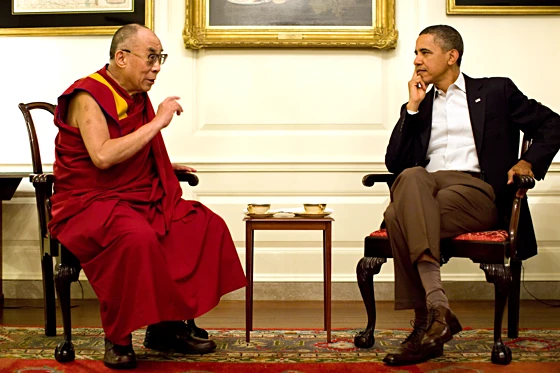
In a previous post I categorised justifications for the idea that Westerners are ill-suited to practice Vajrayana. Those justifications — that our values are incompatible, we can’t commit, our lifestyles do not provide conducive circumstances, or that our karmic connection is lacking — are anecdotally common. Sometimes they are not stated outright but hidden in conciliatory language. My versions of these justifications are stripped down. I wanted to expose them in their most simple form, to make them easier to spot in articles and conversations.
In this post I highlight some generalisations underlying such justifications, then I examine the notion that Western culture is to blame.
The idea that Westerners are ill-suited to Vajrayana assumes a comparison between ‘Westerners’ and ‘non-Westerners’. Who are the ‘non-Westerners’ intended? It’s useful first to clarify the underlying comparison. It could pertain to racial or ethnic differences, culture, socio-economic class, or nationality. Often it turns out that the intended comparison is some vague distinction between Westerners and Tibetans or Asians, not non-Westerners per se.
Stereotypes are best met with precision. If you encounter a sweeping generalization about Western practitioners being an ill-fit for Vajrayana, first try to establish who would be a good fit? How are they different? Why are they more suited to Vajrayana practice?
Referring to the concept of Orientalism might help that endeavour.
“East vs. West”
Orientalism essentialises Eastern societies as unchanging and undeveloped against the superiority of post-Enlightenment, developed Western society. Occidentalism is Orientalism’s counterpart: a view from Eastern societies that stereotypes the West. The view of a profane West versus a pure Eastern tradition draws on this type of cultural idealism.
These broad stereotypes are increasingly old-fashioned and irrelevant. Some comparisons you might find more useful than the myths of the East versus West narrative are:
- pre-industrial vs. post-industrial society
- communal vs. systematized social organisation
- middle-class vs. working class behaviours
- contrasting socio-cultural mores and norms
There are now millions of middle-class people who have never been to Western countries who live and think with a post-capitalist mindset. There are millions of Westerners who hold pre-systematised worldviews with communal priorities. Many of us function at times with a mixture of both.
This reality makes the argument ‘Vajrayana is too hard for Westerners’ seem senseless, yet I believe it is still quite common to hear it in Tibetan Buddhist circles.
Vajrayana shouldn’t work better for some cultures than others
Do our cultural norms make Vajrayana peculiarly inaccessible? They shouldn’t.
The argument that Western culture degenerates personal qualities so much as to make Vajrayana inaccessible goes something like this:
“Western individualist values are antithetical to spiritual practice. The norms of devotion and kindness so important to Vajrayana are far from Western materialist ideals. Consumer culture is fast and superficial. Spirituality is no longer an integral part of our social being; we’ve lost it and therefore we have to go looking for it and start at the beginning. “
One of the principle functions of Vajrayana is to undermine habitual references. In practice, this means our cultural and social references become transparent to us. We begin to see how we use culturally produced, shared norms to prove the illusion of our own substantiality. Vajrayana hacks our culturally and personally configured code. If this is not working in contemporary societies, then Vajrayana is not functioning as it should.
“What do we want? Vajrayana! When do we want it? In due course!”
There are examples of successful Vajrayana programs in the West – though fewer than other types of Buddhism. Why isn’t there at least one Vajrayana center with a resident teacher in every city?
One answer is that other forms of Buddhism scale easily. Most Sutric Buddhisms, including Tibetan Mahayana, Zen, and Theravada seek emptiness or no-self. The goal of emptiness is independent of cultural forms. It does not look particularly different when it crosses a cultural or social boundary. The detail of the method is the same, whatever the time and place. If our practice is to turn away from the cycle of self-perpetuating suffering, cut our ties to desire, see the truth of impermanence everywhere, the details of our cultural circumstances are irrelevant. These models scale easily across cultures. They operate at the general human level. The personality of the individual and their cultural patterns are unimportant for the practice.
Vajrayana differs from other Buddhisms in that experiential emptiness is not its goal. It starts from the emptiness of experience and from this ground it engages with forms. It is closely involved with the stuff of cultural and personal difference. It does not reject conditioning, it utilizes it. To do that well, Vajrayana must become intimate with cultural norms and specifics.
It takes time to develop cultural software. Contemporary society is the most diverse ever. Our challenge today may be the need for more varied Vajrayana programs, precisely because we live in a culture that values individualism, autonomy and diversity. If we understand culture as integral to our personalities, the raw material of our human behaviour to be transformed through Vajrayana practice, we should not blame Western cultural conditioning for Vajrayana not working.
If Vajrayana is less effective than it might be, maybe it is not because Westerners cannot hack Vajrayana, but because Vajrayana is not hacking the West?
Questions for readers:
Is it surprising that Vajrayana isn’t more readily available?
Are current Vajrayanas at odds with Western students? Which should change?
